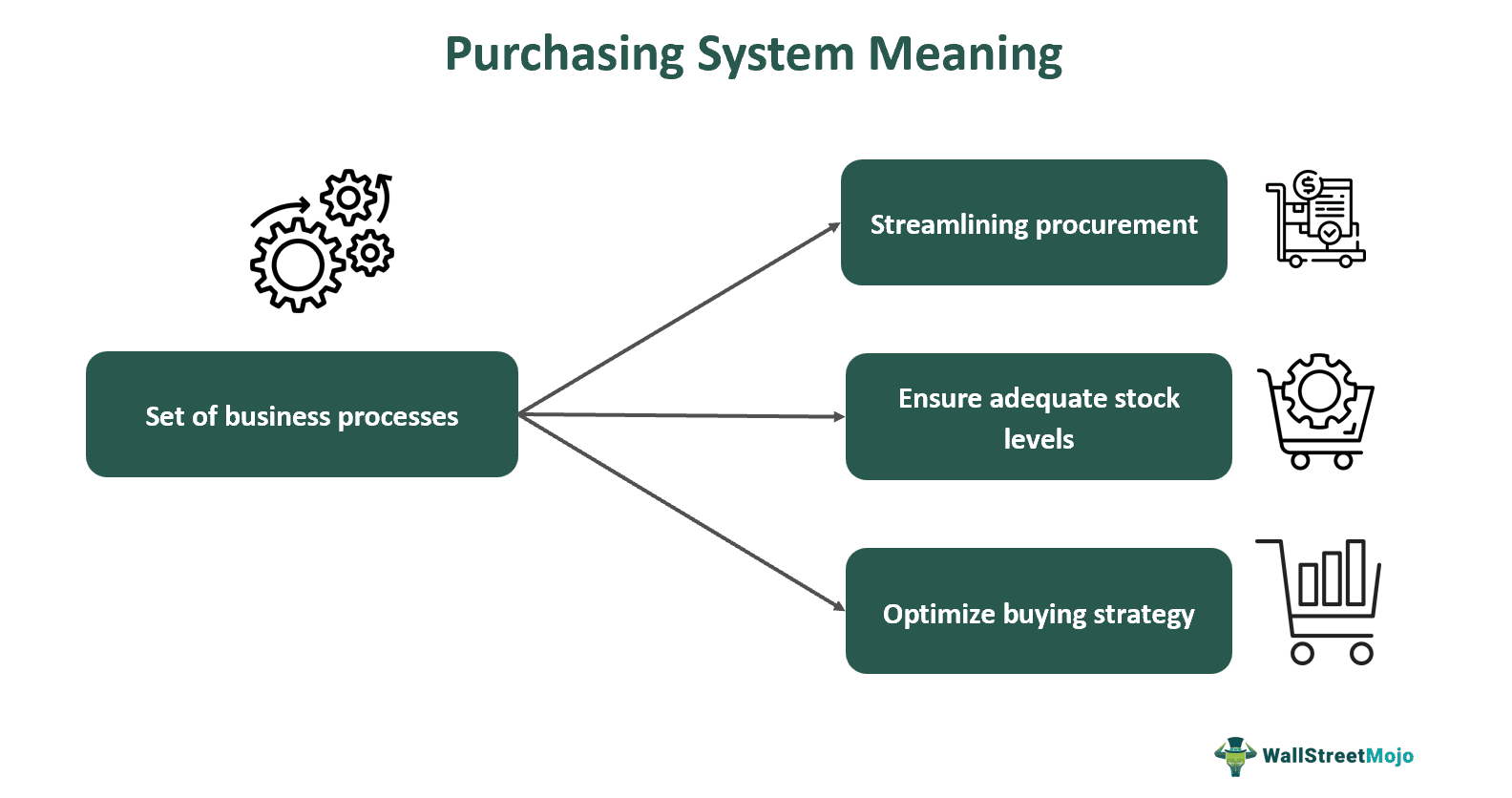Table of Contents
What Is A Purchasing System?
A purchasing system facilitates acquiring goods/services from requisition to payment. It oversees inventory, guiding buying decisions based on stock monitoring, quantity determination, and optimal timing. Employing models like economic order quantity enhances efficient inventory management and procurement processes for companies.

It plays a pivotal role by streamlining procurement, ensuring adequate stock levels, and optimizing buying strategies. They enhance cost efficiency, minimize inventory carrying costs, prevent stockouts, and foster smoother operations. Their significance lies in bolstering financial control, supplier relationships, and overall operational efficiency within organizations.
Key Takeaways
- The purchasing System manages buying processes from requisition to payment, streamlining procurement for businesses.
- Enhances efficiency by automating order placement, invoices, and supplier management. It drives cost savings through better negotiation and minimizing excess inventory costs.
- It is of various types, such as stockless systems, blanket orders, e-purchasing, rate contract methods, and capital equipment purchases.
- It holds immense significance as they efficiently orchestrate procurement processes, optimizing inventory management and buying decisions.
Purchasing System Explained
A purchasing system functions by integrating various stages of procurement. Initially, it assesses inventory levels, considering historical data and forecasts. Upon identifying needs, it defines what, how much, and when to purchase, utilizing tools like economic order quantity models for optimal quantities.
The process involves creating purchase orders, communicating with suppliers, and tracking goods from order placement to receipt. Automation within this system expedites tasks like order management and invoice processing, as well as maintaining an organized supplier database for streamlined communication and future transactions.
More advanced systems leverage automation to place orders automatically based on preset parameters, manage supplier contracts, and sync seamlessly with accounting software, ensuring accurate financial records. Continuous updates of inventory levels and purchase information maintain real-time visibility and facilitate informed decision-making.
Overall, this system acts as the backbone of efficient procurement, orchestrating the entire cycle from demand forecasting to order placement, receipt, and accounting, optimizing inventory management, and enhancing operational effectiveness.
Types
There are different types, as mentioned below:
- Stockless Purchase System: In this approach, the supplier maintains inventory until the customer requests the items. This method reduces the need for the buyer to store excess inventory, allowing for more efficient use of resources.
- Blanket Order: Companies place small, frequent orders as needed instead of larger, less frequent ones. It's suitable for items needed regularly but in varying quantities, allowing for flexibility and just-in-time inventory management.
- E-Purchasing: Utilizes online platforms for buying and selling goods, services, or supplies. It leverages the internet for procurement, streamlining the process and often offering a wide array of options and competitive pricing.
- Rate Contract Method: Establishes predetermined parameters for purchasing goods or services. It helps in standardizing purchases, ensuring consistency, and negotiating better prices based on long-term commitments or bulk orders.
- Capital Equipment Purchase: This involves the acquisition of high-value, long-term assets like machinery or infrastructure. This type of purchase demands significant capital investment and often requires thorough evaluation, planning, and budgeting.
Examples
Let us look at some examples to understand the concept better:
Example #1
Let's consider a hypothetical example of a company implementing a stockless purchase system:
**Company X** operates a small bakery. Instead of storing large quantities of perishable ingredients like flour, sugar, and butter, they opt for a stockless purchase system. They have an agreement with a local supplier who keeps track of their usual ingredient requirements.
When the bakery runs low on flour, instead of placing a traditional order, the supplier immediately delivers a fresh batch. The bakery doesn't need to dedicate space or resources to stockpiling large quantities of flour, ensuring they always have fresh ingredients while minimizing excess inventory costs.
This dynamic purchasing system allows the bakery to maintain flexibility in its inventory management. They can focus on their core business of baking without worrying about storage constraints or the risk of ingredients expiring.
Example #2
Let's see an example of the concept of e-purchasing:
Company XYZ operates an e-commerce platform selling tech gadgets. To manage their inventory efficiently, they utilize purchasing system software. They've established contracts with various suppliers through an online portal.
When stocks of a particular gadget start dwindling, the system automatically generates purchase orders based on preset inventory thresholds. These orders are placed directly through the e-purchasing platform, ensuring a seamless procurement process.
The system not only facilitates timely restocking but also allows for easy comparison of prices and quality from multiple suppliers. Through this method, Company Y optimizes its inventory levels, ensuring they have a consistent supply of products to meet customer demand while leveraging the convenience and speed of online purchasing.
Benefits
The various benefits of this system are as follows:
- Optimized Stock Levels: By tracking inventory and analyzing purchasing patterns, these systems help maintain optimal stock levels, reducing excess or insufficient inventory.
- Cost Efficiency: They enable better negotiation with suppliers, volume discounts, and efficient use of resources, reducing procurement costs.
- Streamlined Processes: It automates tasks like order placement, invoicing, and supplier management, saving time and minimizing errors.
- Improved Decision-Making: Real-time data and analytics provided by these systems aid in informed decision-making regarding purchasing strategies and supplier relationships.
- Preventing Stockouts: Forecasting demand and automating reordering processes help prevent stockouts, ensuring products are available when needed.
- Enhanced Supplier Relationships: Streamlined communication and consistent orders foster stronger relationships with suppliers, potentially leading to better terms and reliability.
